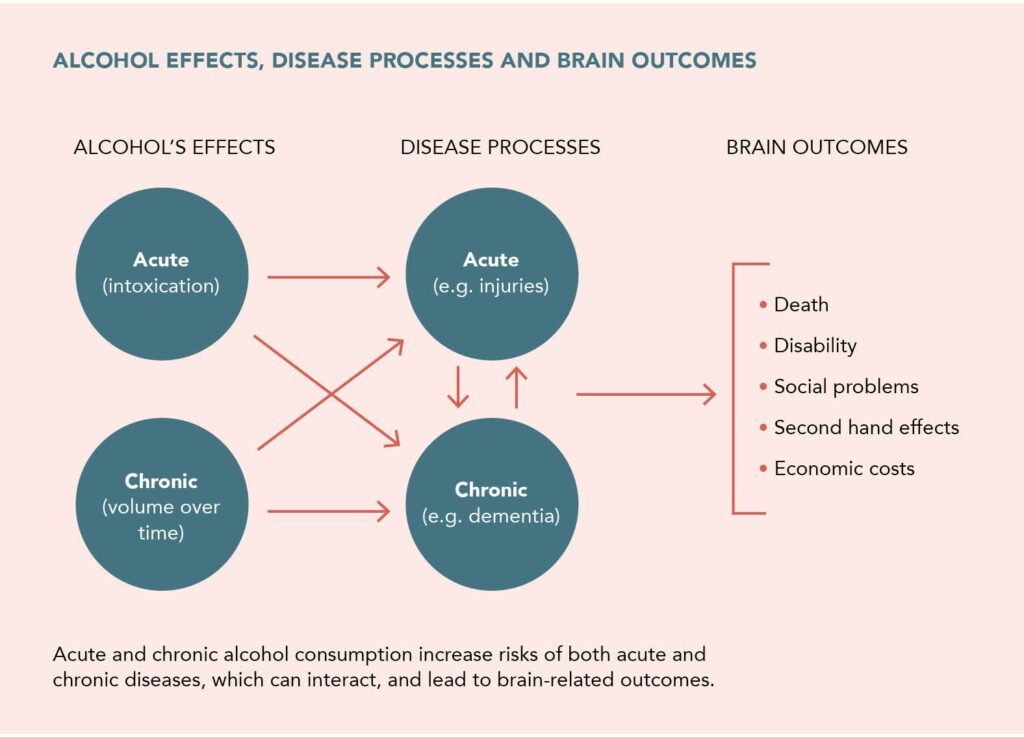1. Dannenhoffer, C. A., Robertson, M. M., Macht, V. A., Mooney, S. M., Boettiger, C. A., & Robinson, D. L. (2021). Chronic alcohol exposure during critical developmental periods differentially impacts persistence of deficits in cognitive flexibility and related circuitry. In International Review of Neurobiology (Vol. 160, pp. 117–173). Elsevier. https://doi.org/10.1016/bs.irn.2021.07.004
2. Pérez-García, J. M., Suárez-Suárez, S., Doallo, S., & Cadaveira, F. (2022). Effects of binge drinking during adolescence and emerging adulthood on the brain: A systematic review of neuroimaging studies. Neuroscience & Biobehavioral Reviews, 137, 104637. https://doi.org/10.1016/j.neubiorev.2022.104637
3. Wolfe, M., Menon, A., Oto, M., Fullerton, N. E., & Leach, J.-P. (2023). Alcohol and the central nervous system. Practical Neurology, 23(4), Article 4. https://doi.org/10.1136/pn-2023-003817
4. Nutt, D., Hayes, A., Fonville, L., Zafar, R., Palmer, E. O. C., Paterson, L., & Lingford-Hughes, A. (2021). Alcohol and the Brain. Nutrients, 13(11), Article 11. https://doi.org/10.3390/nu13113938
5. Kesserwani, H. (2021). Migraine Triggers: An Overview of the Pharmacology, Biochemistry, Atmospherics, and Their Effects on Neural Networks. Cureus. https://doi.org/10.7759/cureus.14243
6. Hu, N., Ma, Y., He, J., Zhu, L., & Cao, S. (2020). Alcohol consumption and incidence of sleep disorder: A systematic review and meta-analysis of cohort studies. Drug and Alcohol Dependence, 217, 108259. https://doi.org/10.1016/j.drugalcdep.2020.108259
7. Kiss, O., Goldstone, A., de Zambotti, M., Yüksel, D., Hasler, B. P., Franzen, P. L., Brown, S. A., De Bellis, M. D., Nagel, B. J., Nooner, K. B., Tapert, S. F., Colrain, I. M., Clark, D. B., & Baker, F. C. (2023). Effects of emerging alcohol use on developmental trajectories of functional sleep measures in adolescents. SLEEP, zsad113. https://doi.org/10.1093/sleep/zsad113
8. Meyrel, M., Rolland, B., & Geoffroy, P. A. (2020). Alterations in circadian rhythms following alcohol use: A systematic review. Progress in Neuro-Psychopharmacology and Biological Psychiatry, 99, 109831. https://doi.org/10.1016/j.pnpbp.2019.109831
9. Cheng, C., Huang, C.-L., Tsai, C.-J., Chou, P.-H., Lin, C.-C., & Chang, C.-K. (2017). Alcohol-Related Dementia: A Systemic Review of Epidemiological Studies. Psychosomatics, 58(4), Article 4. https://doi.org/10.1016/j.psym.2017.02.012
10. Smyth, A., O’Donnell, M., Rangarajan, S., Hankey, G. J., Oveisgharan, S., Canavan, M., McDermott, C., Xavier, D., Zhang, H., Damasceno, A., Avezum, A., Pogosova, N., Oguz, A., Ryglewicz, D., Iversen, H. K., Lanas, F., Rosengren, A., Yusuf, S., Langhorne, P., & on behalf of the INTERSTROKE Investigators. (2023). Alcohol Intake as a Risk Factor for Acute Stroke: The INTERSTROKE Study. Neurology, 100(2), Article 2. https://doi.org/10.1212/WNL.0000000000201388
11. Andréasson, S., Chikritzhs, T., Dangardt, F., Holder, H., Naimi, T., & Stockwell, T. (2019). Alcohol and older people (Alcohol and Society). Swedish Society of Medicine, Swedish Society of Nursing, CERA & IOGT-NTO.
12. Fekjaer, H. O. (2013). Alcohola universal preventive agent? A critical analysis. Addiction (Abingdon, England), 108(12), 2051–2057. https://doi.org/10.1111/add.12104
13. Naimi, T. S., Brown, D. W., Brewer, R. D., Giles, W. H., Mensah, G., Serdula, M. K., Mokdad, A. H., Hungerford, D. W., Lando, J., Naimi, S., & Stroup, D. F. (2005). Cardiovascular risk factors and confounders among nondrinking and moderate drinking U.S. adults. American Journal of Preventive Medicine, 28(4), 369–373. https://doi.org/10.1016/j.amepre.2005.01.011
14. Andréasson, S., Chikritzhs, T., Dangardt, F., Holder, H., Naimi, T., & Stockwell, T. (2014). The Effects of Low-dose Alcohol Consumption (Alcohol and Society, pp. 6–23). http://urn.kb.se/resolve?urn=urn:nbn:se:iogt-2014-aos-en
15. Liang, W., & Chikritzhs, T. (2013). Observational research on alcohol use and chronic disease outcome: New approaches to counter biases. TheScientificWorldJournal, 2013, 860915. https://doi.org/10.1155/2013/860915
16. Zhao, J., Stockwell, T., Roemer, A., Naimi, T., & Chikritzhs, T. (2017). Alcohol Consumption and Mortality From Coronary Heart Disease: An Updated Meta-Analysis of Cohort Studies. Journal of Studies on Alcohol and Drugs, 78(3), Article 3. https://doi.org/10.15288/jsad.2017.78.375
17. Naimi, T. S., Stockwell, T., Zhao, J., Xuan, Z., Dangardt, F., Saitz, R., Liang, W., & Chikritzhs, T. (2017). Selection biases in observational studies affect associations between ‘moderate’ alcohol consumption and mortality. Addiction (Abingdon, England), 112(2), 207–214. https://doi.org/10.1111/add.13451
18. Sattar, N., & Preiss, D. (2017). Reverse Causality in Cardiovascular Epidemiological Research: More Common Than Imagined? Circulation, 135(24), 2369–2372. https://doi.org/10.1161/CIRCULATIONAHA.117.028307
19. Holder, H., Chikritzhs, T., Naimi, T., Andréasson, S., & Stockwell, T. (2013). Alcohol and Society: Youth and young adults (Alcohol and Society). IOGT-NTO, Swedish Society of Medicine.
20. Andréasson, S., Chikritzhs, T., Dangardt, F., Holder, H., Naimi, T., & Stockwell, T. (2015). Second-hand effects of alcohol consumption (Alcohol and Society).
21. Andréasson, S., Chikritzhs, T., Dangardt, F., Holder, H., Naimi, T., & Stockwell, T. (2017). Alcohol and violence (Alcohol and Society).
22. Martin, T. L., Solbeck, P. A. M., Mayers, D. J., Langille, R. M., Buczek, Y., & Pelletier, M. R. (2013). A Review of Alcohol-Impaired Driving: The Role of Blood Alcohol Concentration and Complexity of the Driving Task. Journal of Forensic Sciences, 58(5), Article 5. https://doi.org/10.1111/1556-4029.12227
23. Taylor, B., Irving, H. M., Kanteres, F., Room, R., Borges, G., Cherpitel, C., Greenfield, T., & Rehm, J. (2010). The more you drink, the harder you fall: A systematic review and meta-analysis of how acute alcohol consumption and injury or collision risk increase together. Drug and Alcohol Dependence, 110(1–2), Article 1–2. https://doi.org/10.1016/j.drugalcdep.2010.02.011
24. Irwin, C., Iudakhina, E., Desbrow, B., & McCartney, D. (2017). Effects of acute alcohol consumption on measures of simulated driving: A systematic review and meta-analysis. Accident; Analysis and Prevention, 102, 248–266. https://doi.org/10.1016/j.aap.2017.03.001
25. Chikritzhs, T., & Livingston, M. (2021). Alcohol and the Risk of Injury. Nutrients, 13(8), Article 8. https://doi.org/10.3390/nu13082777
26. Dawson, D., & Reid, K. (1997). Fatigue, alcohol and performance impairment. Nature, 388(6639), Article 6639. https://doi.org/10.1038/40775
27. Zoethout, R. W. M., Delgado, W. L., Ippel, A. E., Dahan, A., & van Gerven, J. M. A. (2011). Functional biomarkers for the acute effects of alcohol on the central nervous system in healthy volunteers. British Journal of Clinical Pharmacology, 71(3), 331–350. https://doi.org/10.1111/j.1365-2125.2010.03846.x
28. Bjork, J. M., & Gilman, J. M. (2014). The effects of acute alcohol administration on the human brain: Insights from neuroimaging. Neuropharmacology, 84, 101–110. https://doi.org/10.1016/j.neuropharm.2013.07.039
29. Jacob, A., & Wang, P. (2020). Alcohol Intoxication and Cognition: Implications on Mechanisms and Therapeutic Strategies. Frontiers in Neuroscience, 14, 102. https://doi.org/10.3389/fnins.2020.00102
30. WHO. (2018, September 6). GHO | By category | Regional prevalence, AAFs (15+), road traffic crash deaths – By WHO region. WHO; World Health Organization. https://apps.who.int/gho/data/view.main.A1082v
31. Borges, G., Cherpitel, C., Orozco, R., Bond, J., Ye, Y., Macdonald, S., Rehm, J., & Poznyak, V. (2006). Multicentre study of acute alcohol use and non-fatal injuries: Data from the WHO collaborative study on alcohol and injuries. Bulletin of the World Health Organization, 84(6), 453–460. https://doi.org/10.2471/blt.05.027466
32. Kassym, L., Kussainova, A., Semenova, Y., Kussainov, A., Marapov, D., Zhanaspayev, M., Urazalina, Z., Akhmetova, A., Tokanov, M., Smail, Y., & Bjørklund, G. (2023). Worldwide Prevalence of Alcohol Use in Non-Fatally Injured Motor Vehicle Drivers: A Systematic Review and Meta-Analysis. Healthcare (Basel, Switzerland), 11(5), Article 5. https://doi.org/10.3390/healthcare11050758
33. Høye, A. K., & Storesund Hesjevoll, I. (2023). Alcohol and driving—How bad is the combination? A meta-analysis. Traffic Injury Prevention, 24(5), Article 5. https://doi.org/10.1080/15389588.2023.2204984
34. WHO. (2018). Global status report on alcohol and health 2018. World Health Organization. https://iris.who.int/handle/10665/274603
35. Moskowitz, H., & Fiorentino, D. (2000). A Review of the Scientific Literature Regarding the Effects of Alcohol on Driving-Related Behavior at blood alcohol concentrations of 0.08 grams per deciliter and lower (Final Report DOT HS 809 028). U.S.Department of Transportation, National Highway Traffic Safety Administration.
36. Rezaee-Zavareh, M. S., Salamati, P., Ramezani-Binabaj, M., Saeidnejad, M., Rousta, M., Shokraneh, F., & Rahimi-Movaghar, V. (2017). Alcohol consumption for simulated driving performance: A systematic review. Chinese Journal of Traumatology, 20(3), Article 3. https://doi.org/10.1016/j.cjtee.2017.04.002
37. Ogden, E. J. D., & Moskowitz, H. (2004). Effects of alcohol and other drugs on driver performance. Traffic Injury Prevention, 5(3), 185–198. https://doi.org/10.1080/15389580490465201
38. Jones, A. (2022). How Nordic Countries Enforce Impaired Driving Legislation. Forensic Science Review, 34(2), 131–143.
39. Exum, M. L. (2006). Alcohol and aggression: An integration of findings from experimental studies. Journal of Criminal Justice, 34(2), Article 2. https://doi.org/10.1016/j.jcrimjus.2006.01.008
40. Abbey, A., Wegner, R., Woerner, J., Pegram, S. E., & Pierce, J. (2014). Review of Survey and Experimental Research That Examines the Relationship Between Alcohol Consumption and Men’s Sexual Aggression Perpetration. Trauma, Violence, & Abuse, 15(4), 265–282. https://doi.org/10.1177/1524838014521031
41. Attwood, A. S., & Munafò, M. R. (2014). Effects of acute alcohol consumption and processing of emotion in faces: Implications for understanding alcohol-related aggression. Journal of Psychopharmacology (Oxford, England), 28(8), Article 8. https://doi.org/10.1177/0269881114536476
42. Crane, C. A., Godleski, S. A., Przybyla, S. M., Schlauch, R. C., & Testa, M. (2016). The Proximal Effects of Acute Alcohol Consumption on Male-to-Female Aggression: A Meta-Analytic Review of the Experimental Literature. Trauma, Violence & Abuse, 17(5), Article 5. https://doi.org/10.1177/1524838015584374
43. Reay, A. M., & Browne, K. D. (2001). Risk factor characteristics in carers who physically abuse or neglect their elderly dependants. Aging & Mental Health, 5(1), Article 1. https://doi.org/10.1080/13607860020020654
44. Nordström, P., Nordström, A., Eriksson, M., Wahlund, L.-O., & Gustafson, Y. (2013). Risk factors in late adolescence for young-onset dementia in men: A nationwide cohort study. JAMA Internal Medicine, 173(17), Article 17. https://doi.org/10.1001/jamainternmed.2013.9079
45. Caputo, C., Wood, E., & Jabbour, L. (2016). Impact of fetal alcohol exposure on body systems: A systematic review. Birth Defects Research. Part C, Embryo Today: Reviews, 108(2), Article 2. https://doi.org/10.1002/bdrc.21129
46. Terasaki, L. S., Gomez, J., & Schwarz, J. M. (2016). An examination of sex differences in the effects of early-life opiate and alcohol exposure. Philosophical Transactions of the Royal Society of London. Series B, Biological Sciences, 371(1688), Article 1688. https://doi.org/10.1098/rstb.2015.0123
47. Popova, S., Charness, M. E., Burd, L., Crawford, A., Hoyme, H. E., Mukherjee, R. A. S., Riley, E. P., & Elliott, E. J. (2023). Fetal alcohol spectrum disorders. Nature Reviews Disease Primers, 9(1), Article 1. https://doi.org/10.1038/s41572-023-00420-x
48. Seemiller, L. R., & Gould, T. J. (2020). The effects of adolescent alcohol exposure on learning and related neurobiology in humans and rodents. Neurobiology of Learning and Memory, 172, 107234. https://doi.org/10.1016/j.nlm.2020.107234
49. Hua, J. P. Y., Sher, K. J., Boness, C. L., Trela, C. J., McDowell, Y. E., Merrill, A. M., Piasecki, T. M., & Kerns, J. G. (2020). Prospective Study Examining the Effects of Extreme Drinking on Brain Structure in Emerging Adults. Alcoholism, Clinical and Experimental Research, 44(11), 2200–2211. https://doi.org/10.1111/acer.14446
50. Linden-Carmichael, A. N., Mogle, J., & Miller, S. E. (2023). Associations between black-out drinking and self-reported everyday cognition among young adults. Addictive Behaviors, 141, 107653. https://doi.org/10.1016/j.addbeh.2023.107653
51. Raninen, J., Larm, P., Svensson, J., Livingston, M., Sjödin, L., & Karlsson, P. (2021). Normalization of Non-Drinking? Health, School Situation and Social Relations among Swedish Ninth Graders That Drink and Do Not Drink Alcohol. International Journal of Environmental Research and Public Health, 18(21), Article 21. https://doi.org/10.3390/ijerph182111201
52. Whatnall, M., Ashton, L., Patterson, A., Smith, J., Duncan, M., Burrows, T., Kay-Lambkin, F., & Hutchesson, M. (2022). Are health behaviors associated with academic performance among tertiary education students? A systematic review of cohort studies. Journal of American College Health, 1–13. https://doi.org/10.1080/07448481.2022.2063024
53. Garduno, A. C., Laughlin, G. A., Bergstrom, J., Tu, X. M., Cummins, K. M., Franz, C. E., Elman, J. A., Lyons, M. J., Reynolds, C. A., Neale, M. C., Gillespie, N. A., Xian, H., McKenzie, R. E., Toomey, R., Kremen, W. S., Panizzon, M. S., & McEvoy, L. K. (2023). Alcohol use and cognitive aging in middleaged men: The Vietnam Era Twin Study of Aging. Journal of the International Neuropsychological Society, 29(3), Article 3. https://doi.org/10.1017/S1355617722000169
54. Enstad, F., Pedersen, W., & von Soest, T. (2023). Adolescent and Young Adult Drunkenness and Future Educational Attainment and Labor Market Integration: A Population-Based Longitudinal Study. Journal of Studies on Alcohol and Drugs, 84(1), Article 1. https://doi.org/10.15288/jsad.21-00395
55. Zhou, T., Sun, D., Li, X., Ma, H., Heianza, Y., & Qi, L. (2021). Educational attainment and drinking behaviors: Mendelian randomization study in UK Biobank. Molecular Psychiatry, 26(8), Article 8. https://doi.org/10.1038/s41380-019-0596-9
56. Brennan, S. E., McDonald, S., Page, M. J., Reid, J., Ward, S., Forbes, A. B., & McKenzie, J. E. (2020). Long-term effects of alcohol consumption on cognitive function: A systematic review and dose-response analysis of evidence published between 2007 and 2018. Systematic Reviews, 9(1), 33. https://doi.org/10.1186/s13643-019-1220-4
57. Hingson, R. W., Heeren, T., & Winter, M. R. (2006). Age of alcohol-dependence onset: Associations with severity of dependence and seeking treatment. Pediatrics, 118(3), e755-763. https://doi.org/10.1542/peds.2006-0223
58. Lewis, M. (2019). Brain Change in Addiction as Learning, Not Disease. The New England Journal of Medicine, 380(3), 301–302. https://doi.org/10.1056/NEJMc1815144
59. West, R., & Brown, J. (2014). Theory of addiction (2nd edition). Wiley Blackwell/Addiction Press.
60. Abbott, C. W., Rohac, D. J., Bottom, R. T., Patadia, S., & Huffman, K. J. (2018). Prenatal Ethanol Exposure and Neocortical Development: A Transgenerational Model of FASD. Cerebral Cortex, 28(8), 2908–2921. https://doi.org/10.1093/cercor/bhx168
61. Akison, L. K., Moritz, K. M., & Reid, N. (2019). Adverse reproductive outcomes associated with fetal alcohol exposure: A systematic review. Reproduction, 157(4), 329–343. https://doi.org/10.1530/REP-18-0607
62. Ramlau-Hansen, C. H., Toft, G., Jensen, M. S., Strandberg-Larsen, K., Hansen, M. L., & Olsen, J. (2010). Maternal alcohol consumption during pregnancy and semen quality in the male offspring: Two decades of follow-up. Human Reproduction (Oxford, England), 25(9), Article 9. https://doi.org/10.1093/humrep/deq140
63. VandeVoort, C. A., Grimsrud, K. N., Midic, U., Mtango, N., & Latham, K. E. (2015). Transgenerational effects of binge drinking in a primate model: Implications for human health. Fertility and Sterility, 103(2), Article 2. https://doi.org/10.1016/j.fertnstert.2014.10.051
64. Behnke, M., Smith, V. C., Committee on Substance Abuse, & Committee on Fetus and Newborn. (2013). Prenatal substance abuse: Short- and long-term effects on the exposed fetus. Pediatrics, 131(3), Article 3. https://doi.org/10.1542/peds.2012-3931
65. Heller, M., & Burd, L. (2014). Review of ethanol dispersion, distribution, and elimination from the fetal compartment. Birth Defects Research. Part A, Clinical and Molecular Teratology, 100(4), Article 4. https://doi.org/10.1002/bdra.23232
66. Fox, D. J., Pettygrove, S., Cunniff, C., O’Leary, L. A., Gilboa, S. M., Bertrand, J., Druschel, C. M., Breen, A., Robinson, L., Ortiz, L., Frías, J. L., Ruttenber, M., Klumb, D., Meaney, F. J., & Centers for Disease Control and Prevention (CDC). (2015). Fetal alcohol syndrome among children aged 7-9 years—Arizona, Colorado, and New York, 2010. MMWR. Morbidity and Mortality Weekly Report, 64(3), 54–57.
67. Miller, L., Tolliver, R., Druschel, C., Fox, D., Schoellhorn, J., Podvin, D., Merrick, S., Cuniff, C., Meany, F., Pensak, M., Dominique, Y., Hymbaugh, K., Boyle, C., Baio, J., & Centers for Disease Control and Prevention (CDC). (2002). Fetal Alcohol Syndrome—Alaska, Arizona, Colorado, and New York, 1995–1997. MMWR. Morbidity and Mortality Weekly Report, 51(20), 429–452.
68. May, P. A., Baete, A., Russo, J., Elliott, A. J., Blankenship, J., Kalberg, W. O., Buckley, D., Brooks, M., Hasken, J., Abdul-Rahman, O., Adam, M. P., Robinson, L. K., Manning, M., & Hoyme, H. E. (2014). Prevalence and characteristics of fetal alcohol spectrum disorders. Pediatrics, 134(5), 855–866. https://doi.org/10.1542/peds.2013-3319
69. May, P. A., Chambers, C. D., Kalberg, W. O., Zellner, J., Feldman, H., Buckley, D., Kopald, D., Hasken, J. M., Xu, R., Honerkamp-Smith, G., Taras, H., Manning, M. A., Robinson, L. K., Adam, M. P., Abdul-Rahman, O., Vaux, K., Jewett, T., Elliott, A. J., Kable, J. A., … Hoyme, H. E. (2018). Prevalence of Fetal Alcohol Spectrum Disorders in 4 US Communities. JAMA, 319(5), 474. https://doi.org/10.1001/jama.2017.21896
70. Lange, S., Probst, C., Gmel, G., Rehm, J., Burd, L., & Popova, S. (2017). Global Prevalence of Fetal Alcohol Spectrum Disorder Among Children and Youth: A Systematic Review and Meta-analysis. JAMA Pediatrics, 171(10), 948–956. https://doi.org/10.1001/jamapediatrics.2017.1919
71. Popova, S., Lange, S., Probst, C., Gmel, G., & Rehm, J. (2018). Global prevalence of alcohol use and binge drinking during pregnancy, and fetal alcohol spectrum disorder. Biochemistry and Cell Biology, 96(2), 237–240. https://doi.org/10.1139/bcb-2017-0077
72. Sampson, P. D., Streissguth, A. P., Bookstein, F. L., Little, R. E., Clarren, S. K., Dehaene, P., Hanson, J. W., & Graham, J. M. (1997). Incidence of fetal alcohol syndrome and prevalence of alcohol-related neurodevelopmental disorder. Teratology, 56(5), 317–326. https://doi.org/10.1002/(SICI)1096-9926(199711)56:5<317::AID-TERA5>3.0.CO;2-U
73. Stratton, K., Howe, C., & Battaglia, F. C. (Eds.). (1996). Fetal Alcohol Syndrome: Diagnosis, Epidemiology, Prevention, and Treatment (p. 4991). National Academies Press. https://doi.org/10.17226/4991
74. Lupton, C., Burd, L., & Harwood, R. (2004). Cost of fetal alcohol spectrum disorders. American Journal of Medical Genetics. Part C, Seminars in Medical Genetics, 127C(1), 42–50. https://doi.org/10.1002/ajmg.c.30015
75. Popova, S., Lange, S., Burd, L., & Rehm, J. (2016). The Economic Burden of Fetal Alcohol Spectrum Disorder in Canada in 2013. Alcohol and Alcoholism (Oxford, Oxfordshire), 51(3), 367–375. https://doi.org/10.1093/alcalc/agv117
76. Ericson, L., Magnusson, L., & Hovstadius, B. (2017). Societal costs of fetal alcohol syndrome in Sweden. The European Journal of Health Economics: HEPAC: Health Economics in Prevention and Care, 18(5), 575–585. https://doi.org/10.1007/s10198-016-0811-4
77. Andréasson, S., Chikritzhs, T., Dangardt, F., Holder, H., Naimi, T., & Stockwell, T. (2020). Alcohol, pregnancy and infant health – a shared responsibility (Alcohol and Society).
78. Flak, A. L., Su, S., Bertrand, J., Denny, C. H., Kesmodel, U. S., & Cogswell, M. E. (2014). The association of mild, moderate, and binge prenatal alcohol exposure and child neuropsychological outcomes: A meta-analysis. Alcoholism, Clinical and Experimental Research, 38(1), Article 1. https://doi.org/10.1111/acer.12214
79. Nunez, C. C., Roussotte, F., & Sowell, E. R. (2011). Focus on: Structural and functional brain abnormalities in fetal alcohol spectrum disorders. Alcohol Research & Health: The Journal of the National Institute on Alcohol Abuse and Alcoholism, 34(1), Article 1.
80. Jones, K. L. (2011). The effects of alcohol on fetal development. Birth Defects Research Part C: Embryo Today: Reviews, 93(1), 3–11. https://doi.org/10.1002/bdrc.20200
81. Kingdon, D., Cardoso, C., & McGrath, J. J. (2016). Research Review: Executive function deficits in fetal alcohol spectrum disorders and attention-deficit/hyperactivity disorder – a meta-analysis. Journal of Child Psychology and Psychiatry, and Allied Disciplines, 57(2), 116–131. https://doi.org/10.1111/jcpp.12451
82. Mattson, S. N., Crocker, N., & Nguyen, T. T. (2011). Fetal alcohol spectrum disorders: Neuropsychological and behavioral features. Neuropsychology Review, 21(2), 81–101. https://doi.org/10.1007/s11065-011-9167-9
83. Mattson, S. N., Bernes, G. A., & Doyle, L. R. (2019). Fetal Alcohol Spectrum Disorders: A Review of the Neurobehavioral Deficits Associated With Prenatal Alcohol Exposure. Alcoholism: Clinical and Experimental Research, 43(6), 1046–1062. https://doi.org/10.1111/acer.14040
84. Mattson, S. N., & Riley, E. P. (1998). A review of the neurobehavioral deficits in children with fetal alcohol syndrome or prenatal exposure to alcohol. Alcoholism, Clinical and Experimental Research, 22(2), 279–294. https://doi.org/10.1111/j.1530-0277.1998.tb03651.x
85. Mattson, S. N., & Riley, E. P. (1999). Implicit and explicit memory functioning in children with heavy prenatal alcohol exposure. Journal of the International Neuropsychological Society: JINS, 5(5), 462–471. https://doi.org/10.1017/s1355617799555082
86. Streissguth, A. P., Barr, H., Kogan, J., & Bookstein, F. L. (1996). Understanding the Occurrence of Secondary Disabilities in Clients with Fetal Alcohol Syndrome (FAS) and Fetal Alcohol Effects (FAE). Final Report to the Centers for Disease Control and Prevention (CDC). (96–06; Technical Report). University of Washington.
87. Ferreira, V. K. de L., & Cruz, M. S. (2017). Intelligence and Fetal Alcohol Spectrum Disorders: A Review. Journal of Population Therapeutics and Clinical Pharmacology = Journal De La Therapeutique Des Populations Et De La Pharmacologie Clinique, 24(3), e1–e18. https://doi.org/10.22374/1710-6222.24.3.1
88. Mattson, S. N., Riley, E. P., Gramling, L., Delis, D. C., & Jones, K. L. (1997). Heavy pre-natal alcohol exposure with or without physical features of fetal alcohol syndrome leads to IQ deficits. The Journal of Pediatrics, 131(5), 718–721. https://doi.org/10.1016/s0022-3476(97)70099-4
89. Connor, P. D., Sampson, P. D., Streissguth, A. P., Bookstein, F. L., & Barr, H. M. (2006). Effects of prenatal alcohol exposure on fine motor coordination and balance: A study of two adult samples. Neuropsychologia, 44(5), 744–751. https://doi.org/10.1016/j.neuropsychologia.2005.07.016
90. Doney, R., Lucas, B. R., Jones, T., Howat, P., Sauer, K., & Elliott, E. J. (2014). Fine motor skills in children with prenatal alcohol exposure or fetal alcohol spectrum disorder. Journal of Developmental and Behavioral Pediatrics: JDBP, 35(9), 598–609. https://doi.org/10.1097/DBP.0000000000000107
91. Adnams, C. M., Kodituwakku, P. W., Hay, A., Molteno, C. D., Viljoen, D., & May, P. A. (2001). Patterns of cognitive-motor development in children with fetal alcohol syndrome from a community in South Africa. Alcoholism, Clinical and Experimental Research, 25(4), 557–562.
92. Kalberg, W. O., Provost, B., Tollison, S. J., Tabachnick, B. G., Robinson, L. K., Eugene Hoyme, H., Trujillo, P. M., Buckley, D., Aragon, A. S., & May, P. A. (2006). Comparison of motor delays in young children with fetal alcohol syndrome to those with prenatal alcohol exposure and with no prenatal alcohol exposure. Alcoholism, Clinical and Experimental Research, 30(12), 2037–2045. https://doi.org/10.1111/j.1530-0277.2006.00250.x
93. Lucas, B. R., Latimer, J., Pinto, R. Z., Ferreira, M. L., Doney, R., Lau, M., Jones, T., Dries, D., & Elliott, E. J. (2014). Gross motor deficits in children prenatally exposed to alcohol: A meta-analysis. Pediatrics, 134(1), e192-209. https://doi.org/10.1542/peds.2013-3733
94. Bertrand, J., Floyd, L. L., Weber, M. K., & Fetal Alcohol Syndrome Prevention Team, Division of Birth Defects and Developmental Disabilities, National Center on Birth Defects and Developmental Disabilities, Centers for Disease Control and Prevention (CDC). (2005). Guidelines for identifying and referring persons with fetal alcohol syndrome. MMWR. Recommendations and Reports: Morbidity and Mortality Weekly Report. Recommendations and Reports, 54(RR-11), 1–14.
95. Kodituwakku, P. W., Handmaker, N. S., Cutler, S. K., Weathersby, E. K., & Handmaker, S. D. (1995). Specific impairments in self-regulation in children exposed to alcohol prenatally. Alcoholism, Clinical and Experimental Research, 19(6), 1558–1564. https://doi.org/10.1111/j.1530-0277.1995.tb01024.x
96. Nanson, J. L., & Hiscock, M. (1990). Attention deficits in children exposed to alcohol prenatally. Alcoholism, Clinical and Experimental Research, 14(5), 656–661. https://doi.org/10.1111/j.1530-0277.1990.tb01223.x
97. Streissguth, A. P., Sampson, P. D., Olson, H. C., Bookstein, F. L., Barr, H. M., Scott, M., Feldman, J., & Mirsky, A. F. (1994). Maternal drinking during pregnancy: Attention and short-term memory in 14-year-old offspring–a longitudinal prospective study. Alcoholism, Clinical and Experimental Research, 18(1), 202–218. https://doi.org/10.1111/j.1530-0277.1994.tb00904.x
98. Coles, C. D., Platzman, K. A., Lynch, M. E., & Freides, D. (2002). Auditory and visual sustained attention in adolescents prenatally exposed to alcohol. Alcoholism, Clinical and Experimental Research, 26(2), 263–271.
99. Connor, P. D., Streissguth, A. P., Sampson, P. D., Bookstein, F. L., & Barr, H. M. (1999). Individual differences in auditory and visual attention among fetal alcohol-affected adults. Alcoholism, Clinical and Experimental Research, 23(8), 1395–1402.
100. Mattson, S. N., Calarco, K. E., & Lang, A. R. (2006). Focused and shifting attention in children with heavy prenatal alcohol exposure. Neuropsychology, 20(3), 361–369. https://doi.org/10.1037/0894-4105.20.3.361
101. Rasmussen, C., Tamana, S., Baugh, L., Andrew, G., Tough, S., & Zwaigenbaum, L. (2013). Neuropsychological impairments on the NEPSY-II among children with FASD. Child Neuropsychology: A Journal on Normal and Abnormal Development in Childhood and Adolescence, 19(4), 337–349. https://doi.org/10.1080/09297049.2012.658768
102. Lee, K. T., Mattson, S. N., & Riley, E. P. (2004). Classifying children with heavy prenatal alcohol exposure using measures of attention. Journal of the International Neuropsychological Society: JINS, 10(2), 271–277. https://doi.org/10.1017/S1355617704102142
103. Wozniak, J. R., Riley, E. P., & Charness, M. E. (2019). Clinical presentation, diagnosis, and management of fetal alcohol spectrum disorder. The Lancet. Neurology, 18(8), 760–770. https://doi.org/10.1016/S1474-4422(19)30150-4
104. Abate, P., Pueta, M., Spear, N. E., & Molina, J. C. (2008). Fetal Learning About Ethanol and Later Ethanol Responsiveness: Evidence Against “Safe” Amounts of Prenatal Exposure. Experimental Biology and Medicine, 233(2), 139–154. https://doi.org/10.3181/0703-MR-69
105. Comasco, E., Rangmar, J., Eriksson, U. J., & Oreland, L. (2018). Neurological and neuropsychological effects of low and moderate prenatal alcohol exposure. Acta Physiologica (Oxford, England), 222(1), Article 1. https://doi.org/10.1111/apha.12892
106. GBD Compare Data Visualization. (2020). Institute for Health Metrics and Evaluation (IHME), Seattle, WA: IHME, University of Washington, 2020. http://vizhub.healthdata.org/gbd-compare
107. Giedd, J. N. (2004). Structural magnetic resonance imaging of the adolescent brain. Annals of the New York Academy of Sciences, 1021, 77–85. https://doi.org/10.1196/annals.1308.009
108. Gogtay, N., Giedd, J. N., Lusk, L., Hayashi, K. M., Greenstein, D., Vaituzis, A. C., Nugent, T. F., Herman, D. H., Clasen, L. S., Toga, A. W., Rapoport, J. L., & Thompson, P. M. (2004). Dynamic mapping of human cortical development during childhood through early adulthood. Proceedings of the National Academy of Sciences of the United States of America, 101(21), 8174–8179. https://doi.org/10.1073/pnas.0402680101
109. Lenroot, R. K., & Giedd, J. N. (2006). Brain development in children and adolescents: Insights from anatomical magnetic resonance imaging. Neuroscience and Biobehavioral Reviews, 30(6), 718–729. https://doi.org/10.1016/j.neubiorev.2006.06.001
110. Reiss, A. L., Abrams, M. T., Singer, H. S., Ross, J. L., & Denckla, M. B. (1996). Brain development, gender and IQ in children. A volumetric imaging study. Brain: A Journal of Neurology, 119 ( Pt 5), 1763–1774. https://doi.org/10.1093/brain/119.5.1763
111. Tapert, S. (2022). Alcohol and the Adolescent Brain: What We’ve Learned and Where the Data Are Taking Us. Alcohol Research: Current Reviews, 42(1), Article 1. https://doi.org/10.35946/arcr.v42.1.07
112. Sicher, A. R., Duerr, A., Starnes, W. D., & Crowley, N. A. (2022). Adolescent Alcohol and Stress Exposure Rewires Key Cortical Neurocircuitry. Frontiers in Neuroscience, 16, 896880. https://doi.org/10.3389/fnins.2022.896880
113. Bellis, M. D., Narasimhan, A., Thatcher, D. L., Keshavan, M. S., Soloff, P., & Clark, D. B. (2005). Prefrontal Cortex, Thalamus, and Cerebellar Volumes in Adolescents and Young Adults with Adolescent-Onset Alcohol Use Disorders and Comorbid Mental Disorders. Alcoholism: Clinical and Experimental Research, 29(9), 1590–1600. https://doi.org/10.1097/01.alc.0000179368.87886.76
114. Medina, K. L., McQueeny, T., Nagel, B. J., Hanson, K. L., Schweinsburg, A. D., & Tapert, S. F. (2008). Prefrontal cortex volumes in adolescents with alcohol use disorders: Unique gender effects. Alcoholism, Clinical and Experimental Research, 32(3), 386–394. https://doi.org/10.1111/j.1530-0277.2007.00602.x
115. Jones, S. A., & Nagel, B. J. (2019). Altered frontostriatal white matter microstructure is associated with familial alcoholism and future binge drinking in adolescence. Neuropsychopharmacology, 44(6), 1076–1083. https://doi.org/10.1038/s41386-019-0315-x
116. Bedi, A., McGlinchey, R. E., Salat, D. H., Currao, A., Fonda, J. R., Milberg, W. P., & Fortier, C. B. (2021). Age of onset of adolescent binge drinking is differentially associated with cortical thickness in post-9/11 adult Veterans. Alcoholism, Clinical and Experimental Research, 45(5), 1065–1077. https://doi.org/10.1111/acer.14606
117. Duncan, S. C., Alpert, A., Duncan, T. E., & Hops, H. (1997). Adolescent alcohol use development and young adult outcomes. Drug and Alcohol Dependence, 49(1), 39–48. https://doi.org/10.1016/S0376-8716(97)00137-3
118. Enstad, F., Evans-Whipp, T., Kjeldsen, A., Toumbourou, J. W., & Von Soest, T. (2019). Predicting hazardous drinking in late adolescence/young adulthood from early and excessive adolescent drinking—A longitudinal cross-national study of Norwegian and Australian adolescents. BMC Public Health, 19(1), 790. https://doi.org/10.1186/s12889-019-7099-0
119. Magee, K. E., & Connell, A. M. (2021). The role of substance use coping in linking depression and alcohol use from late adolescence through early adulthood. Experimental and Clinical Psychopharmacology, 29(6), 659–669. https://doi.org/10.1037/pha0000436
120. Santomauro, D. F., Mantilla Herrera, A. M., Shadid, J., Zheng, P., Ashbaugh, C., Pigott, D. M., Abbafati, C., Adolph, C., Amlag, J. O., Aravkin, A. Y., Bang-Jensen, B. L., Bertolacci, G. J., Bloom, S. S., Castellano, R., Castro, E., Chakrabarti, S., Chattopadhyay, J., Cogen, R. M., Collins, J. K., … Ferrari, A. J. (2021). Global prevalence and burden of depressive and anxiety disorders in 204 countries and territories in 2020 due to the COVID-19 pandemic. The Lancet, 398(10312), 1700–1712. https://doi.org/10.1016/S0140-6736(21)02143-7
121. WHO. (2023). Depression. https://www.who.int/health-topics/depression
122. WHO. (2023, March 31). Depressive disorder (depression). https://www.who.int/news-room/fact-sheets/detail/depression
123. Lim, G. Y., Tam, W. W., Lu, Y., Ho, C. S., Zhang, M. W., & Ho, R. C. (2018). Prevalence of Depression in the Community from 30 Countries between 1994 and 2014. Scientific Reports, 8(1), 2861. https://doi.org/10.1038/s41598-018-21243-x
124. WHO. (2014). Preventing suicide: A global imperative. World Health Organization. https://iris.who.int/handle/10665/131056
125. WHO. (2023, August 28). Suicide. https://www.who.int/news-room/fact-sheets/detail/suicide
126. WHO. (2021, February 9). GHO | By category | Suicide rate estimates, age-standardized – Estimates by country. WHO; World Health Organization. https://apps.who.int/gho/data/view.main.MHSUICIDEASDRv?lang=en
127. Fergusson, D. M., Boden, J. M., & Horwood, L. J. (2009). Tests of causal links between alcohol abuse or dependence and major depression. Archives of General Psychiatry, 66(3), 260–266. https://doi.org/10.1001/archgenpsychiatry.2008.543
128. Puddephatt, J., Irizar, P., Jones, A., Gage, S. H., & Goodwin, L. (2022). Associations of common mental disorder with alcohol use in the adult general population: A systematic review and meta-analysis. Addiction, 117(6), Article 6. https://doi.org/10.1111/add.15735
129. Li, J., Wang, H., Li, M., Shen, Q., Li, X., Zhang, Y., Peng, J., Rong, X., & Peng, Y. (2020). Effect of alcohol use disorders and alcohol intake on the risk of subsequent depressive symptoms: A systematic review and meta-analysis of cohort studies. Addiction, 115(7), Article 7. https://doi.org/10.1111/add.14935
130. Hammerton, G., Lewis, G., Heron, J., Fernandes, G., Hickman, M., & Lewis, G. (2023). The association of alcohol dependence and consumption during adolescence with depression in young adulthood, in England: A prospective cohort study. The Lancet Psychiatry, 10(7), Article 7. https://doi.org/10.1016/S2215-0366(23)00138-4
131. Rehm, J., Marmet, S., Anderson, P., Gual, A., Kraus, L., Nutt, D. J., Room, R., Samokhvalov, A. V., Scafato, E., Trapencieris, M., Wiers, R. W., & Gmel, G. (2013). Defining Substance Use Disorders: Do We Really Need More Than Heavy Use? Alcohol and Alcoholism, 48(6), 633–640. https://doi.org/10.1093/alcalc/agt127
132. Peter, L.-J., Rocío, G.-J., Miquel, R., Margalida, G., Adoración, C., María Ángeles, P.-A., Joan, S., Pau, R., & Mauro, G.-T. (2022). Moderate alcohol consumption and depression prevention: A critical review. Actas Espanolas De Psiquiatria, 50(3), Article 3.
133. Visontay, R., Mewton, L., Slade, T., Aris, I. M., & Sunderland, M. (2023). Moderate Alcohol Consumption and Depression: A Marginal Structural Model Approach Promoting Causal Inference. American Journal of Psychiatry, 180(3), Article 3. https://doi.org/10.1176/appi.ajp.22010043
134. Xu, Y., Zeng, L., Zou, K., Shan, S., Wang, X., Xiong, J., Zhao, L., Zhang, L., & Cheng, G. (2021). Role of dietary factors in the prevention and treatment for depression: An umbrella review of meta-analyses of prospective studies. Translational Psychiatry, 11(1), Article 1. https://doi.org/10.1038/s41398-021-01590-6
135. Gémes, K., Forsell, Y., Janszky, I., László, K. D., Lundin, A., Ponce De Leon, A., Mukamal, K. J., & Moller, J. (2019). Moderate alcohol consumption and depression – a longitudinal population-based study in Sweden. Acta Psychiatrica Scandinavica, 139(6), Article 6. https://doi.org/10.1111/acps.13034
136. Fredman Stein, K., Allen, J. L., Robinson, R., Smith, C., Sawyer, K., & Taylor, G. (2022). Do interventions principally targeting excessive alcohol use in young people improve depression symptoms?: A systematic review and meta-analysis. BMC Psychiatry, 22(1), Article 1. https://doi.org/10.1186/s12888-022-04006-x
137. de Boer, N., Vermeulen, J., Lin, B., van Os, J., ten Have, M., de Graaf, R., van Dorsselaer, S., Bak, M., Rutten, B., Batalla, A., Guloksuz, S., & Luykx, J. J. (2023). Longitudinal associations between alcohol use, smoking, genetic risk scoring and symptoms of depression in the general population: A prospective 6-year cohort study. Psychological Medicine, 53(4), Article 4. https://doi.org/10.1017/S0033291721002968
138. Sallis, H. M., Palmer, T., Tilling, K., Davey Smith, G., & Munafò, M. R. (2023). Using allele scores to identify confounding by reverse causation: Studies of alcohol consumption as an exemplar. International Journal of Epidemiology, 52(2), Article 2. https://doi.org/10.1093/ije/dyac165
139. Borges, G., Bagge, C. L., Cherpitel, C. J., Conner, K. R., Orozco, R., & Rossow, I. (2017). A meta-analysis of acute use of alcohol and the risk of suicide attempt. Psychological Medicine, 47(5), 949–957. https://doi.org/10.1017/S0033291716002841
140. Darvishi, N., Farhadi, M., Haghtalab, T., & Poorolajal, J. (2015). Alcohol-related risk of suicidal ideation, suicide attempt, and completed suicide: A meta-analysis. PloS One, 10(5), e0126870. https://doi.org/10.1371/journal.pone.0126870
141. Isaacs, J. Y., Smith, M. M., Sherry, S. B., Seno, M., Moore, M. L., & Stewart, S. H. (2022). Alcohol use and death by suicide: A meta-analysis of 33 studies. Suicide and Life-Threatening Behavior, 52(4), Article 4. https://doi.org/10.1111/sltb.12846
142. Kaplan, M. S., McFarland, B. H., Huguet, N., Conner, K., Caetano, R., Giesbrecht, N., & Nolte, K. B. (2013). Acute alcohol intoxication and suicide: A gender-stratified analysis of the National Violent Death Reporting System. Injury Prevention: Journal of the International Society for Child and Adolescent Injury Prevention, 19(1), 38–43. https://doi.org/10.1136/injuryprev-2012-040317
143. Lange, S., Jiang, H., Kaplan, M. S., Kim, K. V., & Rehm, J. (2023). Association Between Acute Alcohol Use and Firearm-Involved Suicide in the United States. JAMA Network Open, 6(3), e235248. https://doi.org/10.1001/jamanetworkopen.2023.5248
144. Norström, T., & Ramstedt, M. (2018). The Link Between Per Capita Alcohol Consumption and Alcohol-Related Harm in Sweden, 1987-2015. Journal of Studies on Alcohol and Drugs, 79(4), Article 4.
145. Kerr, W. C., Subbaraman, M., & Ye, Y. (2011). Per capita alcohol consumption and suicide mortality in a panel of US states from 1950 to 2002: Alcohol and suicide mortality in the USA. Drug and Alcohol Review, 30(5), Article 5. https://doi.org/10.1111/j.1465-3362.2011.00306.x
146. O’Connor, M. J., Portnoff, L. C., Lebsack-Coleman, M., & Dipple, K. M. (2019). Suicide risk in adolescents with fetal alcohol spectrum disorders. Birth Defects Research, 111(12), 822–828. https://doi.org/10.1002/bdr2.1465
147. Kõlves, K., Chitty, K. M., Wardhani, R., Värnik, A., de Leo, D., & Witt, K. (2020). Impact of Alcohol Policies on Suicidal Behavior: A Systematic Literature Review. International Journal of Environmental Research and Public Health, 17(19), Article 19. https://doi.org/10.3390/ijerph17197030
148. Xuan, Z., Naimi, T. S., Kaplan, M. S., Bagge, C. L., Few, L. R., Maisto, S., Saitz, R., & Freeman, R. (2016). Alcohol Policies and Suicide: A Review of the Literature. Alcoholism: Clinical and Experimental Research, 40(10), Article 10. https://doi.org/10.1111/acer.13203
149. Breslow, R. A., Castle, I.-J. P., Chen, C. M., & Graubard, B. I. (2017). Trends in Alcohol Consumption Among Older Americans: National Health Interview Surveys, 1997 to 2014. Alcoholism, Clinical and Experimental Research, 41(5), 976–986. https://doi.org/10.1111/acer.13365
150. Calvo, E., Medina, J. T., Ornstein, K. A., Staudinger, U. M., Fried, L. P., & Keyes, K. M. (2020). Cross-country and historical variation in alcohol consumption among older men and women: Leveraging recently harmonized survey data in 21 countries. Drug and Alcohol Dependence, 215, 108219. https://doi.org/10.1016/j.drugalcdep.2020.108219
151. Guttormsson, U. (2022). Alkoholvanor hos äldre 2004–2021 (Alchohol consumption of older people 2004–2021) (p. 16). Centralförbundet för alkohol- och narkotikaupplysning. https://www.can.se/app/uploads/2022/11/alkoholvanor-hos-aldre-2004-2021.pdf
152. Han, B. H., Moore, A. A., Sherman, S., Keyes, K. M., & Palamar, J. J. (2017). Demographic trends of binge alcohol use and alcohol use disorders among older adults in the United States, 2005-2014. Drug and Alcohol Dependence, 170, 198–207. https://doi.org/10.1016/j.drugalcdep.2016.11.003
153. Livingston, M., Callinan, S., Dietze, P., Stanesby, O., & Kuntsche, E. (2018). Is there gender convergence in risky drinking when taking birth cohorts into account? Evidence from an Australian national survey 2001-13. Addiction (Abingdon, England), 113(11), 2019–2028. https://doi.org/10.1111/add.14279
154. GBD 2016 Dementia Collaborators. (2019). Global, regional, and national burden of Alzheimer’s disease and other dementias, 1990-2016: A systematic analysis for the Global Burden of Disease Study 2016. The Lancet. Neurology, 18(1), 88–106. https://doi.org/10.1016/S1474-4422(18)30403-4
155. GBD 2019 Dementia Forecasting Collaborators. (2022). Estimation of the global prevalence of dementia in 2019 and forecasted prevalence in 2050: An analysis for the Global Burden of Disease Study 2019. The Lancet. Public Health, 7(2), e105–e125. https://doi.org/10.1016/S2468-2667(21)00249-8
156. WHO. (2019). Risk reduction of cognitive decline and dementia: WHO guidelines. World Health Organization. https://iris.who.int/handle/10665/312180
157. Wimo, A., Seeher, K., Cataldi, R., Cyhlarova, E., Dielemann, J. L., Frisell, O., Guerchet, M., Jönsson, L., Malaha, A. K., Nichols, E., Pedroza, P., Prince, M., Knapp, M., & Dua, T. (2023). The worldwide costs of dementia in 2019. Alzheimer’s & Dementia: The Journal of the Alzheimer’s Association, 19(7), 2865–2873. https://doi.org/10.1002/alz.12901
158. Wimo, A., Jönsson, L., Fratiglioni, L., Sandman, P. O., Gustavsson, A., Sköldunger, A., & Johansson, L. (2016). The societal costs of dementia in Sweden 2012 – Relevance and methodological challenges in valuing informal care. Alzheimer’s Research & Therapy, 8(1), 59. https://doi.org/10.1186/s13195-016-0215-9
159. WHO. (2017). Global action plan on the public health response to dementia 2017–2025. World Health Organization. https://iris.who.int/handle/10665/259615
160. Andréasson, S., Chikritzhs, T., Dangardt, F., Holder, H., Naimi, T., & Stockwell, T. (2023). Alcohol and blood pressure (Alcohol and Society). CERA, SFAM, Swedish Society of Nursing, SAFF, Movendi International, Riksförbundet HjärtLung, SLAN, Swedish society of addiction medicine, SIGHT, IOGT-NTO.
161. Chandrakumar, A., Bhardwaj, A., & ‘T Jong, G. W. (2019). Review of thiamine deficiency disorders: Wernicke encephalopathy and Korsakoff psychosis. Journal of Basic and Clinical Physiology and Pharmacology, 30(2), 153–162. https://doi.org/10.1515/jbcpp-2018-0075
162. Rehm, J., Hasan, O. S. M., Black, S. E., Shield, K. D., & Schwarzinger, M. (2019). Alcohol use and dementia: A systematic scoping review. Alzheimer’s Research & Therapy, 11(1), Article 1. https://doi.org/10.1186/s13195-018-0453-0
163. Schwarzinger, M., Pollock, B. G., Hasan, O. S. M., Dufouil, C., Rehm, J., & QalyDays Study Group. (2018). Contribution of alcohol use disorders to the burden of dementia in France 2008-13: A nationwide retrospective cohort study. The Lancet. Public Health, 3(3), Article 3. https://doi.org/10.1016/S2468-2667(18)30022-7
164. Mewton, L., Visontay, R., Hoy, N., Lipnicki, D. M., Sunderland, M., Lipton, R. B., Guerchet, M., Ritchie, K., Najar, J., Scarmeas, N., Kim, K., Riedel Heller, S., van Boxtel, M., Jacobsen, E., Brodaty, H., Anstey, K. J., Haan, M., Scazufca, M., Lobo, E., … Collaborators from the Cohort Studies of Memory in an International Consortium (COSMIC). (2023). The relationship between alcohol use and dementia in adults aged more than 60 years: A combined analysis of prospective, individual-participant data from 15 international studies. Addiction, 118(3), Article 3. https://doi.org/10.1111/add.16035
165. Bosi, M., Malavolti, M., Garuti, C., Tondelli, M., Marchesi, C., Vinceti, M., & Filippini, T. (2022). Environmental and lifestyle risk factors for early-onset dementia: A systematic review: Environmental factors and EOD risk. Acta Biomedica Atenei Parmensis, 93(6), Article 6. https://doi.org/10.23750/abm.v93i6.13279
166. Kilian, C., Klinger, S., Rehm, J., & Manthey, J. (2023). Alcohol use, dementia risk, and sex: A systematic review and assessment of alcohol-attributable dementia cases in Europe. BMC Geriatrics, 23(1), Article 1. https://doi.org/10.1186/s12877-023-03972-5
167. Lao, Y., Hou, L., Li, J., Hui, X., Yan, P., & Yang, K. (2021). Association between alcohol intake, mild cognitive impairment and progression to dementia: A dose-response meta-analysis. Aging Clinical and Experimental Research, 33(5), Article 5. https://doi.org/10.1007/s40520-020-01605-0
168. Wiegmann, C., Mick, I., Brandl, E. J., Heinz, A., & Gutwinski, S. (2020). Alcohol and Dementia – What is the Link? A Systematic Review. Neuropsychiatric Disease and Treatment, 16, 87–99. https://doi.org/10.2147/NDT.S198772
169. Xie, C., & Feng, Y. (2022). Alcohol consumption and risk of Alzheimer’s disease: A dose-response meta-analysis. Geriatrics & Gerontology International, 22(4), Article 4. https://doi.org/10.1111/ggi.14357
170. Xu, W., Wang, H., Wan, Y., Tan, C., Li, J., Tan, L., & Yu, J.-T. (2017). Alcohol consumption and dementia risk: A dose-response meta-analysis of prospective studies. European Journal of Epidemiology, 32(1), 31–42. https://doi.org/10.1007/s10654-017-0225-3
171. Westman, J., Wahlbeck, K., Laursen, T. M., Gissler, M., Nordentoft, M., Hällgren, J., Arffman, M., & Ösby, U. (2015). Mortality and life expectancy of people with alcohol use disorder in Denmark, Finland and Sweden. Acta Psychiatrica Scandinavica, 131(4), 297–306. https://doi.org/10.1111/acps.12330
172. Mukamal, K. J. (2003). Prospective Study of Alcohol Consumption and Risk of Dementia in Older Adults. JAMA, 289(11), 1405. https://doi.org/10.1001/jama.289.11.1405
173. Ganguli, M., Bilt, J. V., Saxton, J. A., Shen, C., & Dodge, H. H. (2005). Alcohol consumption and cognitive function in late life: A longitudinal community study. Neurology, 65(8), 1210–1217. https://doi.org/10.1212/01.wnl.0000180520.35181.24
174. Naimi, T. S., Stadtmueller, L. A., Chikritzhs, T., Stockwell, T., Zhao, J., Britton, A., Saitz, R., & Sherk, A. (2019). Alcohol, Age, and Mortality: Estimating Selection Bias Due to Premature Death. Journal of Studies on Alcohol and Drugs, 80(1), Article 1.
175. Almeida, O. P., Hankey, G. J., Yeap, B. B., Golledge, J., & Flicker, L. (2014). Alcohol consumption and cognitive impairment in older men: A mendelian randomization study. Neurology, 82(12), 1038–1044. https://doi.org/10.1212/WNL.0000000000000255
176. Andrews, S. J., Goate, A., & Anstey, K. J. (2020). Association between alcohol consumption and Alzheimer’s disease: A Mendelian randomization study. Alzheimer’s & Dementia, 16(2), Article 2. https://doi.org/10.1016/j.jalz.2019.09.086
177. Larsson, S. C., Traylor, M., Malik, R., Dichgans, M., Burgess, S., & Markus, H. S. (2017). Modifiable pathways in Alzheimer’s disease: Mendelian randomisation analysis. BMJ, j5375. https://doi.org/10.1136/bmj.j5375
178. Verbaten, M. N. (2009). Chronic effects of low to moderate alcohol consumption on structural and functional properties of the brain: Beneficial or not? Human Psycho-pharmacology, 24(3), Article 3. https://doi.org/10.1002/hup.1022
179. Day, S. M., Gironda, S. C., Clarke, C. W., Snipes, J. A., Nicol, N. I., Kamran, H., Vaughan, W., Weiner, J. L., & Macauley, S. L. (2023). Ethanol exposure alters Alzheimer’s-related pathology, behavior, and metabolism in APP/PS1 mice. Neurobiology of Disease, 177, 105967. https://doi.org/10.1016/j.nbd.2022.105967
180. Hoffman, J. L., Faccidomo, S., Kim, M., Taylor, S. M., Agoglia, A. E., May, A. M., Smith, E. N., Wong, L. C., & Hodge, C. W. (2019). Alcohol drinking exacerbates neural and behavioral pathology in the 3xTg-AD mouse model of Alzheimer’s disease. International Review of Neurobiology, 148, 169–230. https://doi.org/10.1016/bs.irn.2019.10.017
181. Huang, D., Yu, M., Yang, S., Lou, D., Zhou, W., Zheng, L., Wang, Z., Cai, F., Zhou, W., Li, T., & Song, W. (2018). Ethanol Alters APP Processing and Aggravates Alzheimer-Associated Phenotypes. Molecular Neurobiology, 55(6), 5006–5018. https://doi.org/10.1007/s12035-017-0703-3
182. Deuschl, G., Beghi, E., Fazekas, F., Varga, T., Christoforidi, K. A., Sipido, E., Bassetti, C. L., Vos, T., & Feigin, V. L. (2020). The burden of neurological diseases in Europe: An analysis for the Global Burden of Disease Study 2017. The Lancet. Public Health, 5(10), e551–e567. https://doi.org/10.1016/S2468-2667(20)30190-0
183. GBD 2017 US Neurological Disorders Collaborators, Feigin, V. L., Vos, T., Alahdab, F., Amit, A. M. L., Bärnighausen, T. W., Beghi, E., Beheshti, M., Chavan, P. P., Criqui, M. H., Desai, R., Dhamminda Dharmaratne, S., Dorsey, E. R., Wilder Eagan, A., Elgendy, I. Y., Filip, I., Giampaoli, S., Giussani, G., Hafezi-Nejad, N., … Murray, C. J. L. (2021). Burden of Neurological Disorders Across the US From 1990-2017: A Global Burden of Disease Study. JAMA Neurology, 78(2), 165–176. https://doi.org/10.1001/jamaneurol.2020.4152
184. Girotra, T., Lekoubou, A., Bishu, K. G., & Ovbiagele, B. (2020). A contemporary and comprehensive analysis of the costs of stroke in the United States. Journal of the Neurological Sciences, 410, 116643. https://doi.org/10.1016/j.jns.2019.116643
185. Patra, J., Taylor, B., Irving, H., Roerecke, M., Baliunas, D., Mohapatra, S., & Rehm, J. (2010). Alcohol consumption and
the risk of morbidity and mortality for different stroke types –
A systematic review and meta-analysis. BMC Public Health, 10, 258. https://doi.org/10.1186/1471-2458-10-258
186. Rehm, J., Shield, K. D., Roerecke, M., & Gmel, G. (2016). Modelling the impact of alcohol consumption on cardiovascular disease mortality for comparative risk assessments: An overview. BMC Public Health, 16, 363. https://doi.org/10.1186/s12889-016-3026-9
187. Jones, S. B., Loehr, L., Avery, C. L., Gottesman, R. F., Wruck, L., Shahar, E., & Rosamond, W. D. (2015). Midlife Alcohol Consumption and the Risk of Stroke in the Atherosclerosis Risk in Communities Study. Stroke, 46(11), 3124–3130. https://doi.org/10.1161/STROKEAHA.115.010601
188. Wood, A. M., Kaptoge, S., Butterworth, A. S., Willeit, P., Warnakula, S., Bolton, T., Paige, E., Paul, D. S., Sweeting, M., Burgess, S., Bell, S., Astle, W., Stevens, D., Koulman, A., Selmer, R. M., Verschuren, W. M. M., Sato, S., Njølstad, I., Woodward, M., … Danesh, J. (2018). Risk thresholds for alcohol consumption: Combined analysis of individual-participant data for 599 912 current drinkers in 83 prospective studies. The Lancet, 391(10129), Article 10129. https://doi.org/10.1016/S0140-6736(18)30134-X
189. Holmes, M. V., Dale, C. E., Zuccolo, L., Silverwood, R. J., Guo, Y., Ye, Z., Prieto-Merino, D., Dehghan, A., Trompet, S., Wong, A., Cavadino, A., Drogan, D., Padmanabhan, S., Li, S., Yesupriya, A., Leusink, M., Sundstrom, J., Hubacek, J. A., Pikhart, H., … on behalf of The InterAct Consortium. (2014). Association between alcohol and cardiovascular disease: Mendelian randomisation analysis based on individual participant data. BMJ, 349(jul10 6), Article jul10 6. https://doi.org/10.1136/bmj.g4164
190. Millwood, I. Y., Walters, R. G., Mei, X. W., Guo, Y., Yang, L., Bian, Z., Bennett, D. A., Chen, Y., Dong, C., Hu, R., Zhou, G., Yu, B., Jia, W., Parish, S., Clarke, R., Davey Smith, G., Collins, R., Holmes, M. V., Li, L., … China Kadoorie Biobank Collaborative Group. (2019). Conventional and genetic evidence on alcohol and vascular disease aetiology: A prospective study of 500 000 men and women in China. Lancet (London, England), 393(10183), Article 10183. https://doi.org/10.1016/S0140-6736(18)31772-0
191. GBD 2019 Diseases and Injuries Collaborators. (2020). Global burden of 369 diseases and injuries in 204 countries and territories, 1990-2019: A systematic analysis for the Global Burden of Disease Study 2019. Lancet (London, England), 396(10258), 1204–1222. https://doi.org/10.1016/S0140-6736(20)30925-9
192. GBD 2017 Causes of Death Collaborators. (2018). Global, regional, and national age-sex-specific mortality for 282 causes of death in 195 countries and territories, 1980-2017: A systematic analysis for the Global Burden of Disease Study 2017. Lancet (London, England), 392(10159), 1736–1788. https://doi.org/10.1016/S0140-6736(18)32203-7
193. Cherpitel, C. J., Witbrodt, J., Ye, Y., & Korcha, R. (2018). A multi-level analysis of emergency department data on drinking patterns, alcohol policy and cause of injury in 28 countries. Drug and Alcohol Dependence, 192, 172–178. https://doi.org/10.1016/j.drugalcdep.2018.07.033
194. Wu, H. Z., Barry, L. C., Duan, Y., Bohannon, R. W., Covault, J. M., & Grady, J. J. (2017). Acute Effects of Moderate Alcohol Consumption on Postural Stability in Older Adults. Perceptual and Motor Skills, 124(5), Article 5. https://doi.org/10.1177/0031512517721069
195. Stenbacka, M., Jansson, B., Leifman, A., & Romelsjö, A. (2002). Association between use of sedatives or hypnotics, alcohol consumption, or other risk factors and a single injurious fall or multiple injurious falls: A longitudinal general population study. Alcohol (Fayetteville, N.Y.), 28(1), 9–16. https://doi.org/10.1016/s0741-8329(02)00223-9
196. Bye, E. K., Bogstrand, S. T., & Rossow, I. (2022). The importance of alcohol in elderly’s hospital admissions for fall injuries: A population case-control study. Nordisk Alkohol- & Narkotikatidskrift: NAT, 39(1), 38–49. https://doi.org/10.1177/14550725211015836
197. Anderson, P., Scafato, E., Galluzzo, L., & VINTAGE project Working Group. (2012). Alcohol and older people from a public health perspective. Annali Dell’Istituto Superiore Di Sanita, 48(3), 232–247. https://doi.org/10.4415/ANN_12_03_04
198. Galluzzo, L., Scafato, E., Martire, S., Anderson, P., Colom, J., Segura, L., McNeill, A., Sovinova, H., Rados Krnel, S., Ahlström, S., & VINTAGE project Working Group. (2012). Alcohol and older people. The European project VINTAGE: Good health into older age. Design, methods and major results. Annali Dell’Istituto Superiore Di Sanita, 48(3), 221–231. https://doi.org/10.4415/ANN_12_03_03
199. Hartikainen, S., Lönnroos, E., & Louhivuori, K. (2007). Medication as a risk factor for falls: Critical systematic review. The Journals of Gerontology. Series A, Biological Sciences and Medical Sciences, 62(10), 1172–1181. https://doi.org/10.1093/gerona/62.10.1172
200. Woolcott, J. C., Richardson, K. J., Wiens, M. O., Patel, B., Marin, J., Khan, K. M., & Marra, C. A. (2009). Meta-analysis of the impact of 9 medication classes on falls in elderly persons. Archives of Internal Medicine, 169(21), 1952–1960. https://doi.org/10.1001/archinternmed.2009.357
201. Laurence, B. D., & Michel, L. (2017). The Fall in Older Adults: Physical and Cognitive Problems. Current Aging Science, 10(3), 185–200. https://doi.org/10.2174/1874609809666160630124552
202. Lipardo, D. S., Aseron, A. M. C., Kwan, M. M., & Tsang, W. W. (2017). Effect of Exercise and Cognitive Training on Falls and Fall-Related Factors in Older Adults With Mild Cognitive Impairment: A Systematic Review. Archives of Physical Medicine and Rehabilitation, 98(10), 2079–2096. https://doi.org/10.1016/j.apmr.2017.04.021
203. Zhang, W., Low, L.-F., Schwenk, M., Mills, N., Gwynn, J. D., & Clemson, L. (2019). Review of Gait, Cognition, and Fall Risks with Implications for Fall Prevention in Older Adults with Dementia. Dementia and Geriatric Cognitive Disorders, 48(1–2), 17–29. https://doi.org/10.1159/000504340
204. Zhao, J., Stockwell, T., Vallance, K., & Hobin, E. (2020). The Effects of Alcohol Warning Labels on Population Alcohol Consumption: An Interrupted Time Series Analysis of Alcohol Sales in Yukon, Canada. Journal of Studies on Alcohol and Drugs, 81(2), Article 2. https://doi.org/10.15288/jsad.2020.81.225








